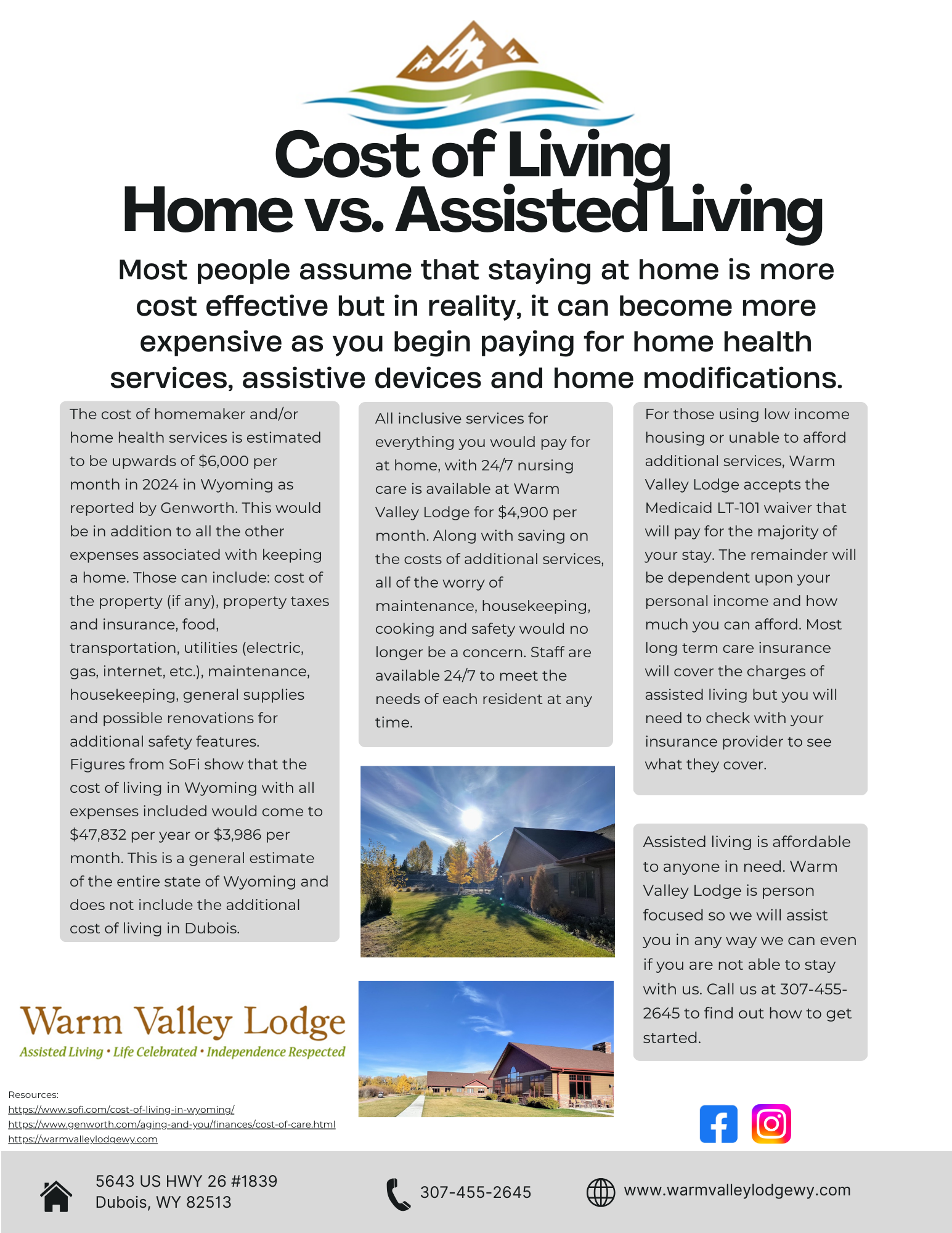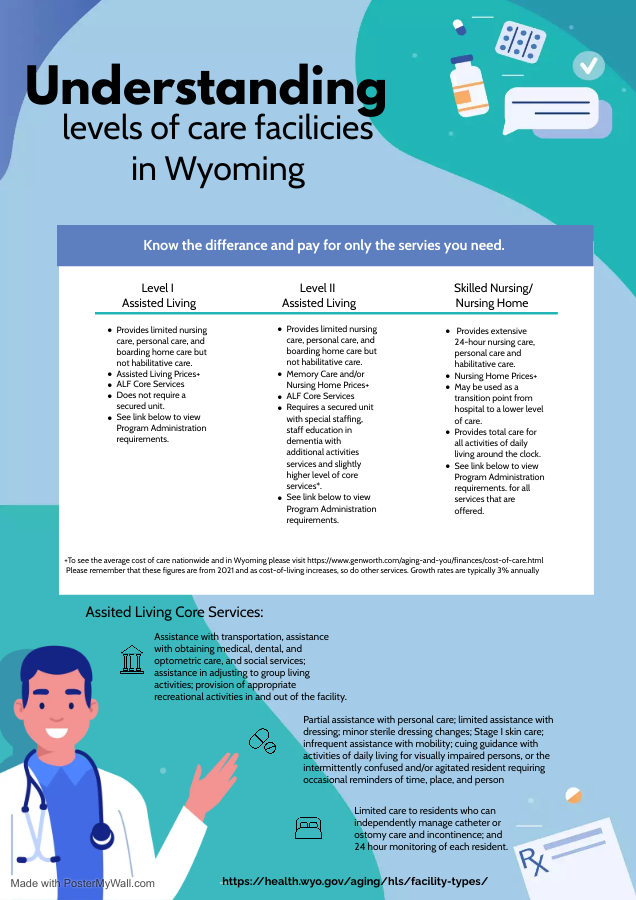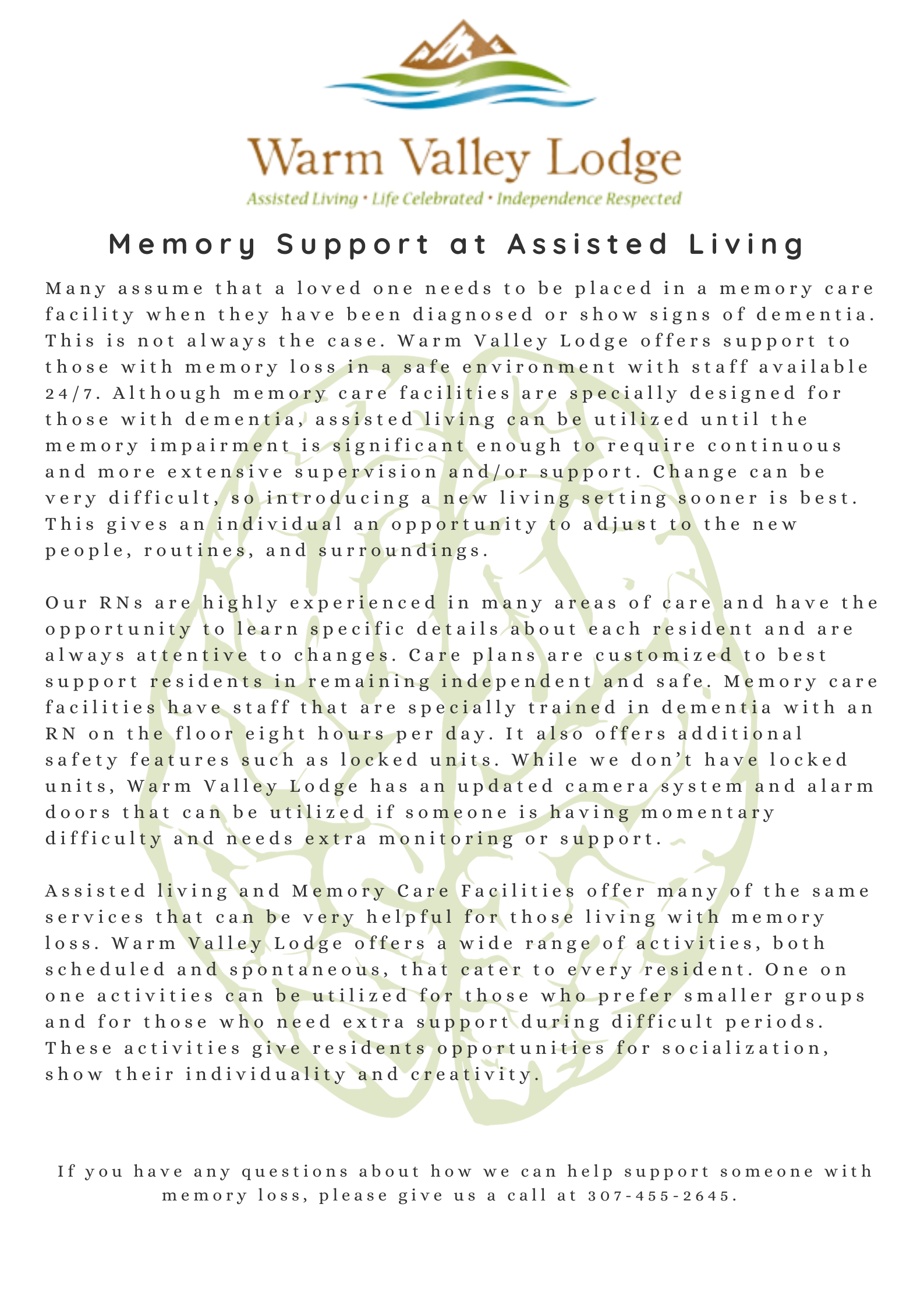Resources
Assisted Living • Life Celebrated • Independence RespectedCost of Living: Home VS ALF

Driving Miss Daisy: Out into the wilderness
After getting cabin fever, who doesn’t want to bust out and go for a ride somewhere?
As Activities Aide at Warm Valley Lodge, the assisted living facility in Dubois, Marcy Leseberg brings residents out at every chance she gets. Besides the scheduled twice-weekly “scenic rides” on the calendar of events, Leseberg loves to offer her friends at the Lodge a spur-of-the-moment drive into the backcountry and beyond. It’s a much better option than just looking at the mountains through the windows.

Marcy and Warm Valley Lodge friends about to leave for a short excursion in the WVL golf cart.
As a born-and-bred resident of the Upper Wind River Valley, she knows exactly where to go.
“East Fork is a rough road,” she said recently, musing about her next drive. “It’s beautiful, but I don’t know how the roads are, after all this rain. Maybe we’ll just go to the Crowheart Store and get an ice cream bar.”
Leseberg says she began these trips during the pandemic.
“This started in April 2020, when I was in housekeeping,” Leseberg says. “We were locked down. We needed something to do, so I just got in the car and started driving. We couldn’t stop or go in anywhere. We just drove around.”
Born in Crowheart, Leseberg knows the back roads and has the personal history to provide narration to match the itinerary, after a childhood of Saturday night visits to neighbors when her Dad would fiddle or play the guitar. During the recent pandemic, always with a few residents in tow, “we went to Morton Lake, Ocean Lake, we toured the big town of Pavilion,” she says. “We drove by the farm I was raised on. I took them past the church where my sister and I got locked in the outhouse during a church meeting. Stuff like that you don’t forget, and the residents love those kinds of stories.”
On a memorable eight-hour drive during the worst of those long months, she drove one resident and her oxygen equipment to Fort Washakie, Arapahoe, and all the way to Red Canyon beyond Lander. “We ate Kentucky Fried Chicken in the car, because we weren’t allowed to go out anywhere,” she recalls.
Leseberg hasn’t hosted a four-hour or seven-hour excursion since COVID-19 has waned, because now her passengers can do things like travel up to Union Pass and eat at the Crooked Creek Restaurant or go dancing to Packin’ the Mail during Music at the Museum in town. At last, they can get out of the vehicle and interact with people.
Watching the Native American Eagle Spirit Dancers was a highlight, one resident said. She loved the music, the dancing, and the performers themselves. “I’m from Oklahoma, and I’ve been to a lot of dances with the Five Tribes,” she recalls, “and I’m just fascinated with Native Americans, so I just walked up and talked to them.”
“After three years of doing this, it’s great to see people get out and socialize,” Leseberg says. “Everyone in the town knows their names. It makes them feel like they belong.”
Horizons are even wider now, after a region-wide appeal generated funds to buy “Miss Daisy” – Warm Valley Lodge’s new van. It can transport up to eight residents, along with their necessary equipment. The old SUV could only accommodate three passengers and a driver. Leaving the SUV free for local errands and doctor visits, the van allows the road-trip crew a much longer range. Next on the list is the National Museum of Wildlife Art in Jackson, the Wind River Wild Horse Sanctuary and picnics in the mountains next summer.
Leseberg says the van’s increased capacity encourages more lively conversations during the trips. One of the regular passengers brought up different advantages.
“The van is higher,” that passenger said. “You can see more animals, more countryside. And I love waving at people I know when we drive by.
Restoring a ‘basic human right’, through food
They were probably the wittiest couple in town back then, and they loved giving dinner parties. She usually planned them around a theme, like Mexican or Asian, with place settings to match. Gregarious and wry, she was a terrific hostess.
But then she needed surgery, and afterwards it all got to be too much to take on.
These days the couple eats out sometimes. But mostly they enjoy the dinner entrees and side dishes of their choice, prepared by a chef who had a lifetime of experience in Jackson, and delivered directly to their dining table.
“Oh, no. Now I will have to think again,” joked the husband, when he heard that as residents of Warm Valley Lodge, the assisted living residence in Dubois, he and his wife would begin making their own choices from regularly changing menus.
But later he remarked: “We’re not eating out as much as we used to. It really makes a difference.”
One of the founding principles of assisted living is to encourage autonomy and independence among people as they age. The basic idea is to provide a real home where residents can follow a normal life, while escaping the most burdensome obligations of household activities as they grow older, including cooking, which may be a considerable sacrifice in its own way.
“The ability to make decisions intentionally and independently is a basic human right, yet people living in residential aged care facilities often give up a certain amount of their right to choose what to eat or drink,” wrote the authors of a study published three years ago in the “Journal of Clinical Nursing,” adding that “the loss of autonomy to make food choices is of particular concern, as a lack of choice decreases motivation to eat, placing residents at risk of malnutrition and reducing their quality of life.”
Several recent studies have found that when diners at residences for the elderly are given meal choices, they tend to eat sensibly and tend not to lose weight (which is a major contributor to frailty). Yet anyone who moves into a “residential care facility” may still face daily fare that is “three slabs of whatever – one green, one orange and then one maybe looks like mashed potato or something with gravy” (as one RN described it).
The report in the nursing journal stated that staff in two Australian facilities were more concerned about the nutritional status of meals than about how they were prepared. “They don’t know how to cook anything,” said one 73-year-old resident. “They walk around with the tops like chefs…but they’re just glorified cooks.”
Allen Sphatt probably didn’t know about any of this research when he answered the ad from Warm Valley Lodge for a new head cook. What he did know was that he had grown very tired of driving back and forth over one mountain pass or another. After losing his lease in Driggs and being priced out of Jackson, he had settled in Dubois. So he answered the ad.
What he also knew was that the customary way of doing things was going to be “ridiculously boring.”
As former head of the commissary at Fine Dining Group, which owns breweries and restaurants in Jackson including the Bistro and Bin 22, Sphatt absolutely deserves to wear the chef’s hat. Before that, he was dinner sous chef at Snow King and executive chef at Spring Creek Ranch.
Warm Valley Lodge had been using a menu service to determine the daily meals. “They outline the meal every day,” he explained. “You pull the menu from the computer, make it, serve it, you’re done.”
Soon after being hired as Dietary Manager, Sphatt suggested a different approach to Margaret Chantry, the administrator of the Lodge, and she let him change the system. Himself a Certified Food Manager, he still relies on the menu service and the contracted registered dietician to determine portion control and dietary needs. But he uses his own recipes.
If an entrée is meatloaf, for example, he starts with the menu-service basics and adds seasonings like Worcestershire sauce and thyme, knowing from experience that they enhance the flavor of the beef. His new clientele gets to choose main meal and breakfast options from menus that change every two weeks.
“Al introduces many new menu items that most of us have never experienced, things that he would make in the past or learned from his family,” remarked Chantry. “Based on comments from our monthly resident council meetings, the residents unanimously favor this new system. Also, the staff enjoys the food just as much as the residents, and we choose it over our own.”
 Preparing a new menu at Warm Valley Lodge requires two days of intense work: putting the main items into the freezer, making the sauces ahead and replacing what is ordered. Afterward, everything is ready to grab and cooked to order—just like in a restaurant.
Preparing a new menu at Warm Valley Lodge requires two days of intense work: putting the main items into the freezer, making the sauces ahead and replacing what is ordered. Afterward, everything is ready to grab and cooked to order—just like in a restaurant.Studies show that kitchen staff at some residences for the aging resist the idea of departing from the institutional menus, because it would require too much extra planning and time. But “it plays into my hands,” Sphatt said.
“That’s my experience—not institutional cooking, restaurant cooking,” he said. “I’ve been doing this for 40 years. It’s not hard. It’s easy.” And it gives the diners something to think about.
Payment Sources

Levels of Care
Memory Care in Assisted Living Facilities








